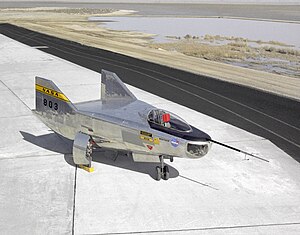M2-F2
| M2-F2 | |
|---|---|
 |
|
| Role | Lifting body technology demonstrator |
| National origin | United States |
| Manufacturer | Northrop |
| First flight | 12 July 1966 |
| Retired | 10 May 1967 |
| Status | Rebuilt as M2-F3 |
| Primary user | NASA |
| Number built | 1 |
| Developed from | NASA M2-F1 |
| Variants | Northrop M2-F3 |
The Northrop M2-F2 was a heavyweight lifting body based on studies at NASA's Ames and Langley research centers and built by the Northrop Corporation in 1966.
The success of Dryden's M2-F1 program led to NASA's development and construction of two heavyweight lifting bodies based on studies at NASA's Ames and Langley research centers—the M2-F2 and the HL-10, both built by the Northrop Corporation. The "M" refers to "manned" and "F" refers to "flight" version. "HL" comes from "horizontal landing" and 10 is for the tenth lifting body model to be investigated by Langley.
The M2-F2 made its first captive flight (attached to the B-52 carrier aircraft throughout the flight) on March 23, 1966.
The first flight of the M2-F2 - which looked much like the M2-F1 - was on July 12, 1966. Milton O. Thompson was the pilot.
By then, the same B-52 used to air launch the famed X-15 rocket research aircraft was modified to also carry the lifting bodies. Thompson was dropped from the B-52's wing pylon mount at an altitude of 45,000 feet (13,700 m) on that maiden glide flight. He reached a gliding speed of about 450 miles per hour (720 km/h).
Before powered flights were undertaken, a series of glide flights were conducted. On May 10, 1967, the sixteenth and last glide flight ended in disaster as the vehicle slammed into the lake bed on landing. With test pilot Bruce Peterson at the controls, the M2-F2 suffered a pilot induced oscillation (PIO) as it neared the lake bed. At the core of this problem was the fact that the wings of the M2-F2 (essentially the body of the aircraft) produced considerably less roll authority than most aircraft. This resulted in less force available to the pilot to control the aircraft in roll. As a consequence, when Peterson attempted to perform roll maneuvers the response of the vehicle was substantially less than expected, thus lending to a "soft" feel for this control which often leads to PIO in the roll axis. (Source: interview with Bruce Peterson, 1980) The vehicle rolled from side to side in flight as he tried to bring it under control. Peterson recovered, but then observed a rescue helicopter that seemed to pose a collision threat. Distracted, Peterson drifted in a crosswind to an unmarked area of the lake bed where it was very difficult to judge the height over the ground because of a lack of guidance (the markers provided on the lake bed runway).
...
Wikipedia
